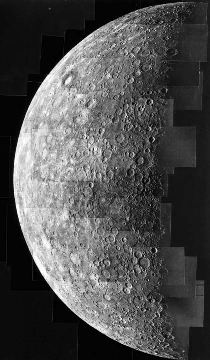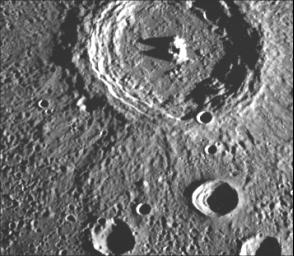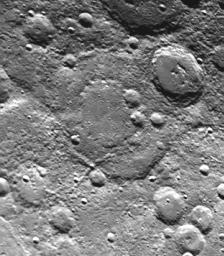Mercury Transit on May 7, 2003 Information about Mercury The innermost planet |  | | Photo of planet Mercury, obtained with NASA's Mariner 10 spacecraft. |
Mercury is the innermost planet in the solar system. Since it is the closest to the Sun, Mercury is the most difficult planet to see because it is always seen quite near to the Sun in the sky and the Sun's glare or the bright sky usually overwhelms the planet's light. The only chance to see it is as a faint "star" in the morning or evening sky near the horizon, shortly before sunrise in the dawn or just after sunset in the dusk. So it has always been almost impossible to get any information about the surface of the planet by means of ground-based observations. The first, detailed images were obtained with the NASA Mariner 10 spacecraft which also procured most of our present information about Mercury's surface. |  |  | | The surface of Mercury is cratered like that of the Moon (NASA's Mariner 10 spacecraft). |
Like our Moon, Mercury is small and its surface is scarred by craters that were formed by impacting rocks and asteroids, soon after the birth of the solar system. They smashed into the planet and blasted the material away from the surface. Mercury also has real cliffs, or scarps which formed when the young cooling planet shrunk like an old apple, with wrinkles on its surface. Mercury has the largest day-to-night temperature variation of all planets. The days are burning hot (about 400 °C) and the nights are freezing cold (about -200 °C). This is because it only has a very thin atmosphere. Only part of Mercury's surface was mapped because Mariner 10 always flew by on the same side. Thus there is still much to be explored on Mercury. The European Space Agency (ESA) is planning to send a spacecraft named BepiColombo to Mercury in 2011-12. Mercury's physical data The table compares some of the physical data of Mercury, the Earth, and the Earth's Moon. As can be seen, Mercury resembles the Moon more than the Earth, except for the density. | Property | | Mercury | | Earth | | Moon | | Distance from the Sun | | 58 million km | | 150 million km | | 150 million km | | Rotation period | | 59 days | | 24 hours | | 27 days 8 hours | | Equatorial radius | | 2240 km | | 6378 km | | 1738 km | | Mass | | 3.30 x 10 23 kg | | 5.97 x 10 24 kg | | 7.35 x 10 22 kg | | Density | | 5430 kg/m 3 | | 5520 kg/m 3 | | 3340 kg/m 3 |
|
|
|
| | |